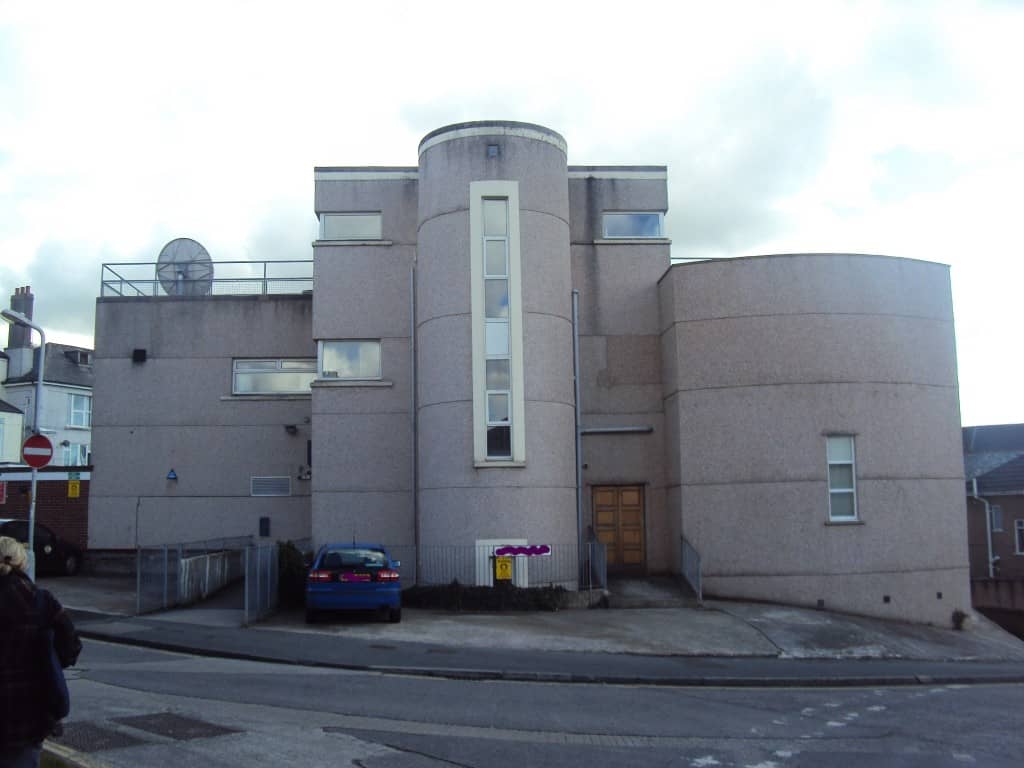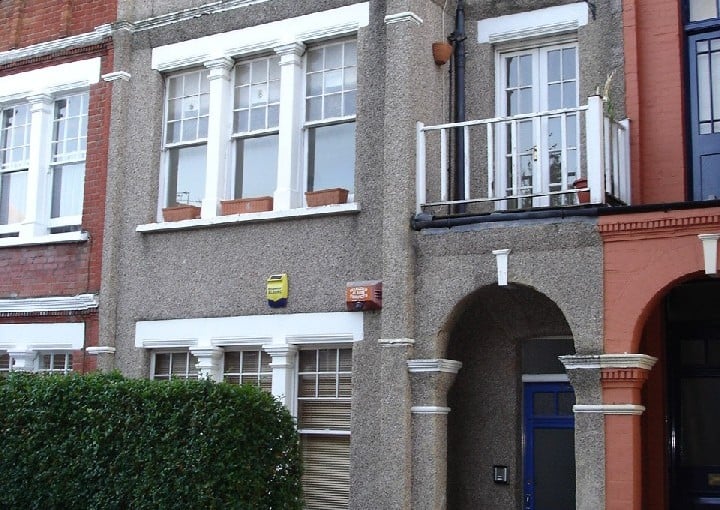What’s the difference between spar dash and pebbledash wall coatings? Both exterior wall coverings are popular options for protecting walls but they are not to everyone’s taste.
Is your home pebbledashed and you hate the look of it?
Each of these wall coatings has their drawbacks as well as advantages. For instance, each can be difficult to paint, but we have a solution.
What is Spar Dash, and why is it so awful?
Spar dash is a wall coating made with a mortar and flint chips literally thrown into wet cement and onto bricks to provide weatherproofing, but it is the nasty stepmother of pebbledash.
Many modern homes described as having a pebbledashed exterior actually have a spar dashed exterior, many people don’t know the difference (Which is why I am writing this)
It has become widely popular across the UK due to its cost effectiveness and low upkeep requirements.
Spar dash is much cheaper and easier to produce as, traditionally, pebbledash was made of of actual pebbles, usually from a beach, dredged up from the sea bed, or quarried where millions of years ago the sea was in place of the land there now.
(A sort of reverse global warming situation.)
However, it’s essential to know that wall coating can be challenging to paint due to its heavily textured surface.
Traditional painting tools (brush and roller) may not be sufficient due to this difficulty, and if you have tried to paint your pebbledashed walls, you will now how long it takes, and the quite frankly crap finish at the end.
Therefore, if you plan on painting your pebbledash wall, it is recommended that you hire a qualified wall coating tradesperson who specialises in this type of task.
Applying multiple coats of paint ensures an even, smooth coat which looks fantastic and lasts. However, remember that due to the texture of this type of render, you may need several applications as it’s difficult to cover all parts of your wall evenly.
The only effective way to paint spar dash and add a splash of colour is via a spray-applied exterior wall coating as it is the only way to effectively cover a very rough textured surface.
This is not a job you can do yourself though. Applying an exterior wall coating not only requires specialist (and expensive) spraying equipment, but also years of training and experience, something that you do not have.
Spar dash is very rough and contains a multitude of extremely sharp edges, and if you are a professional decorator like me, accidentally brushing the back of your hand across a wall with this on it hurts like hell.
It’s nasty, cheap and if used incorrectly, can ruin the character of any building.

Pebbledash. The “marmite” exterior wall covering.
Pebbledash is an exterior wall coating made up of small pebbles and stones embedded in a base of cement or mortar. It’s widely popular for exterior walls due to its frost-proof nature as well as durability.
Pebbledash has the unfortunate characteristic of not being flexible, meaning when water seeps in it can crack the surface.
This allows the underlying brickwork to let in even more water and create dampness within your house.
To prevent cracking, apply multiple layers of pebbledash, although this is not foolproof.
This makes the surface more durable but requires a considerable amount of labour-intensive effort to complete.

People in general do not like pebbledash, which is probably one reason so many people contact us to paint their pebbledashed walls and it is really not a DIY job.
Roughcast is another horrible wall coating
Roughcast (“Harling” in Scotland) is a wet plaster made with lime and cement mixed with sand, gravel and pebbles. This results in an aesthetically appealing wall coating that boasts more texture than regular render, although it’s default colour is grey, but colouring additives can be used.
It has a variety of uses, primarily to provide weatherproof surfaces and conceal uneven or lumpy brickwork.
Much of these textured wall coverings are used to conceal poor quality brickwork beneath, one reason why so many council houses had this done to them in the past.
For instance, it could be applied to timber-framed houses’ panels and even curved walls where brickwork would be too expensive or time-consuming.
Though it is a popular exterior wall finish, there can be downsides too – especially in the UK where water damage is an ongoing concern.
Damp can seep into cracks in any cement-based wall covering, and if not addressed promptly, weaken the underlying structure of a building.
Tyrolean, another terrible idea.
Tyrolean render, also known as Alpine Render, is a cement-based render popularly used in the UK for both residential and commercial buildings. It’s sometimes referred to as ‘Tyrolean Finish’ due to its weathered, heavily textured look similar to pebbledash.
It is normally applied with the tool below, known as a tyrolean gun.

However, this type of wall coating has its drawbacks; we always suggest leaving this task to the professionals. It is a challenging undertaking that necessitates extensive skill, knowledge and experience for successful completion.
The initial step is to mix together a base coat using cement and clean water. It should be thick and creamy with a slightly tacky feel so that it adheres better to walls. A scratch comb can then be used to further make it adhere before applying tyrolean render.
Tyrolean is prone to cracking and offers very little weather resistance.
So the major difference between spar dash and pebbledash is the type of stones used.
Pebbledash contains, literally, pebbles, and spar dash contains flint chips.
Spar dash (sometimes incorrectly called Spa dash) has an advantage in that is cheaper to buy, plus it is available in a much wider range of colours, although the application method remains the same.
Generally pebbledash is of a higher quality than spar dash, and lasts longer.
So what is the solution for ugly spar dash and pebbledash?
There are a few options to consider, all of which require careful consideration before going ahead as they are not generally a cheap option.
Option one: Have a new coat of pebbledash over the old one.
Beware! This is the LEAST recommended option and will be offered to you only by a “cowboy” builder.
Adding more pebbledash does 2 things: It adds WEIGHT to the wall, exceeding your homes load bearing ability, plus if any old pebbledash is cracked or hollow, this will remain hidden and not repaired, leading to damp. This can also invalidate your home buildings insurance.
Secondly, the wall profile will increase, meaning that in a terraced house or a semi, your wall covering will stick out at least an inch over your neighbours walls and will look ridiculous.

Lastly, you may have issues with opening your windows and doors, plus if you do manage to open a window, the pebbles will scratch your upvc.
The above is not recommended and you would be stupid, if you don’t mind me saying, to agree to have work like this done on your home.
Removal and replacement of old pebbledash.
This is also not recommended. The job would probably take a couple of weeks, that is 2 weeks of hairy, sweary workmen, banging, 2 weeks of noise, dust and debris, and guess where that old pebbledash goes?
To landfill, meaning this is the worst for the environment.
Also if your existing pebbledash is firmly stuck to the walls, forced removal will rip out the mortar joints, the pointing which literally holds all the bricks together.
It will also rip out the bricks themselves beneath the pebbledash, undermining the structural stability of your home, and no I am not scaremongering to try and sell you something (!), I write from the point of view of an experienced Master Builder.
Yes, unlike our competitors, all content here is written with AUTHORITY, by a qualified Master Builder, with over 30 years of experience on the tools, NOT by an SEO company.
Repairs to the pebbledash with a spray applied exterior wall coating.

This is by far the least intrusive, and the most cost effective way of dealing with ugly spar dash or pebbledash.
The existing dash is retained and repaired. Bald spots are reinstated and cracks filled, Hollow render is removed and replaced to match, ensuring the building is “sound” and free of any defects, an essential task to ensure the job not only lasts as long as we say it will, but also to avoid damp in the future.
We then mask up the doors and windows to protect them from mess, and lay dust sheets down on the floor.
We then mix up a cement based slurry which is either painted on, or can be sprayed on
This acts as a primer and stabiliser, filling in any tiny holes in the wall and provides a good surface for the painting afterwards.
Once this process has dried, we then hand apply a weatherproof primer across the entire house, and leave a day to dry.
The next stage is to spray the exterior wall coating system on to the house in a good thick coat, in fact 20 times the thickness of ordinary masonry paint, leaving a crisp, clean and hard wearing finish across the entire house.
The system effectively covers and protects the pebbledash, whilst being guaranteed for 20 years to not fade, crack, chip or peel, PLUS the wall coating stops damp, mould and condensation.
This is by far the most effective way to deal with ugly wall coverings such as spar dash or pebbledash, although it is also suitable for brick and render too.
If the wall coating system interests you, why not contact us for a free consultation and price?
You can email us here or call us, FREE, any time Monday to Saturday, on 0800 970 4928

